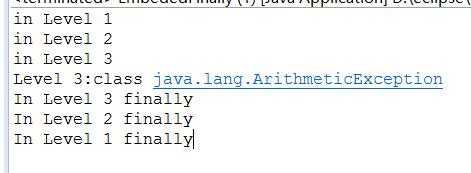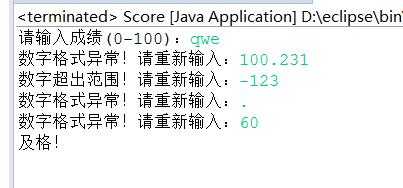标签:char 输出 src 观察 判断 总结 处理 else ble
动手动脑1:请阅读并运行AboutException.java示例,然后通过后面的几页PPT了解Java中实现异常处理的基础知识。
源码:
import javax.swing.*;
class AboutException {
public static void main(String[] a)
{
int i=1, j=0, k;
k=i/j;
try
{
k = i/j; // Causes division-by-zero exception
//throw new Exception("Hello.Exception!");
}
catch ( ArithmeticException e)
{
System.out.println("被0除. "+ e.getMessage());
}
catch (Exception e)
{
if (e instanceof ArithmeticException)
System.out.println("被0除");
else
{
System.out.println(e.getMessage());
}
}
finally
{
JOptionPane.showConfirmDialog(null,"OK");
}
}
}
运行结果:

注释掉第一个 k = i / j;

知识:
1.Try{ //可能发生运行错误的代码; } catch(异常类型 异常对象引用){ //用于处理异常的代码 } finally{ //用于“善后” 的代码 }
2.使用Java异常处理机制
把可能会发生错误的代码放进try语句块中。 当程序检测到出现了一个错误时会抛出一个异常对象。异常处理代码会捕获并处理这个错误。 catch语句块中的代码用于处理错误。 当异常发生时,程序控制流程由try语句块跳转到catch语句块。 不管是否有异常发生,finally语句块中的语句始终保证被执行。 如果没有提供合适的异常处理代码,JVM将会结束掉整个应用程序。
动手动脑2:阅读以下代码(CatchWho.java),写出程序运行结果:
源代码:
public class CatchWho {
public static void main(String[] args) {
try {
try {
throw new ArrayIndexOutOfBoundsException();
}
catch(ArrayIndexOutOfBoundsException e) {
System.out.println( "ArrayIndexOutOfBoundsException" + "/内层try-catch");
}
throw new ArithmeticException();
}
catch(ArithmeticException e) {
System.out.println("发生ArithmeticException");
}
catch(ArrayIndexOutOfBoundsException e) {
System.out.println( "ArrayIndexOutOfBoundsException" + "/外层try-catch");
}
}
}
运行结果:
ArrayIndexOutOfBoundsException/内层try-catch
发生ArithmeticException
动手动脑3:写出CatchWho2.java程序运行的结果
源代码:
public class CatchWho2 {
public static void main(String[] args) {
try {
try {
throw new ArrayIndexOutOfBoundsException();
}
catch(ArithmeticException e) {
System.out.println( "ArrayIndexOutOfBoundsException" + "/内层try-catch");
}
throw new ArithmeticException();
}
catch(ArithmeticException e) {
System.out.println("发生ArithmeticException");
}
catch(ArrayIndexOutOfBoundsException e) {
System.out.println( "ArrayIndexOutOfBoundsException" + "/外层try-catch");
}
}
}
运行结果:
ArrayIndexOutOfBoundsException/外层try-catch
动手动脑4:当有多个嵌套的try…catch…finally时,要特别注意finally的执行时机。 请先阅读 EmbedFinally.java示例,再运行它,观察其输出并进行总结。 特别注意: 当有多层嵌套的finally时,异常在不同的层次抛出 ,在不同的位置抛出,可能会导致不同的finally语句块执行顺序。
源代码:
public class EmbededFinally {
public static void main(String args[]) {
int result;
try {
System.out.println("in Level 1");
try {
System.out.println("in Level 2");
// result=100/0; //Level 2
try {
System.out.println("in Level 3");
result=100/0; //Level 3
}
catch (Exception e) {
System.out.println("Level 3:" + e.getClass().toString());
}
finally {
System.out.println("In Level 3 finally");
}
// result=100/0; //Level 2
}
catch (Exception e) {
System.out.println("Level 2:" + e.getClass().toString());
}
finally {
System.out.println("In Level 2 finally");
}
// result = 100 / 0; //level 1
}
catch (Exception e) {
System.out.println("Level 1:" + e.getClass().toString());
}
finally {
System.out.println("In Level 1 finally");
}
}
}
运行结果:

经过多次修改result = 100 / 0;的位置,可以得知将会跳过剩下的所有直到遇到第一个catch处理错误。继续运行剩下的。
动手动脑5:辨析:finally语句块一定会执行吗? 请通过 SystemExitAndFinally.java示例程序回答上述问题
源代码:
public class SystemExitAndFinally {
public static void main(String[] args)
{
try{
System.out.println("in main");
throw new Exception("Exception is thrown in main");
//System.exit(0);
}
catch(Exception e)
{
System.out.println(e.getMessage());
System.exit(0);
}
finally
{
System.out.println("in finally");
}
}
}
运行结果:

System.exit(0);可以结束一切但是不可以阻止catch异常。
课后作业:编写一个程序,此程序在运行时要求用户输入一个 整数,代表某门课的考试成绩,程序接着给出“不及格”、“及格”、“中”、“良”、“优”的结论。 要求程序必须具备足够的健壮性,不管用户输入什 么样的内容,都不会崩溃。
源代码:
package T9;
import java.util.Scanner;
class MyException extends Exception//输入异常
{
public MyException()
{
}
public MyException(String msg)
{
super(msg);
}
}
public class Score {
public static void main(String[] args) {
Scanner s = new Scanner(System.in);
String str = null;
double score = 0;
boolean flag = false;//判断输入格式正确
System.out.print("请输入成绩(0-100):");
while(!flag)
{
try{
str = s.next();
for(int i = 0;i < str.length();i++)//判断输入的是不是double
{
if(str.length() == 1 && str.charAt(i) == ‘.‘)
throw new MyException("数字格式异常!");
if((str.charAt(i) >= ‘0‘ && str.charAt(i) <= ‘9‘) || str.charAt(i) == ‘.‘)
;
else
throw new MyException("数字格式异常!");
if(i == str.length() - 1)
{
score = Double.parseDouble(str);
if(score > 100.0 || score < 0.0)
throw new MyException("数字超出范围!");
else
flag = true;
}
}
}
catch(MyException e)//异常处理
{
System.out.print(e.getMessage());
System.out.print("请重新输入:");
}
}
if(score >= 90)
System.out.println("优!");
else if(score >= 80)
System.out.println("良!");
else if(score >= 70)
System.out.println("中!");
else if(score >= 60)
System.out.println("及格!");
else
System.out.println("不及格!");
}
}
运行结果:

标签:char 输出 src 观察 判断 总结 处理 else ble
原文地址:http://www.cnblogs.com/fylove/p/6102958.html